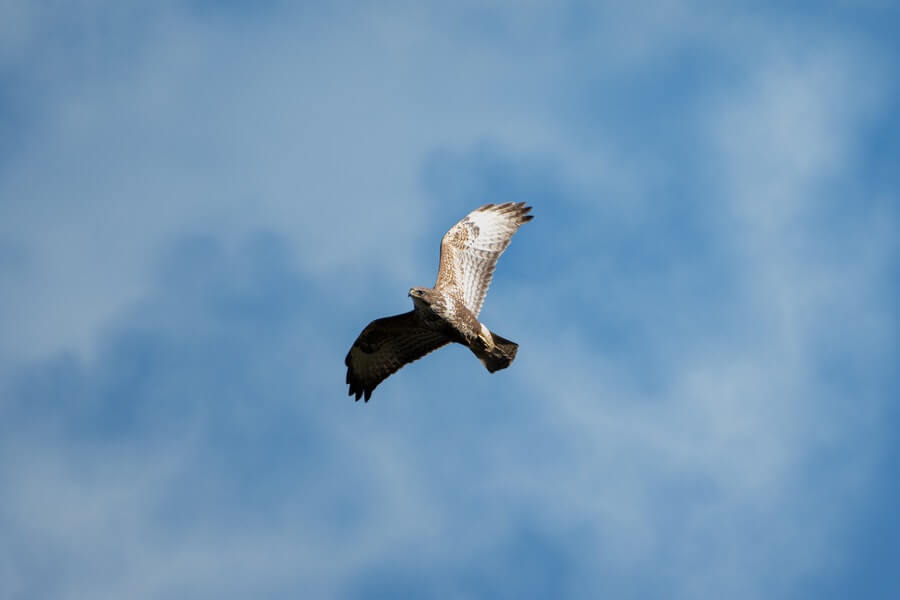Some of the most majestic birds in the animal kingdom are also the deadliest for other smaller birds and animals. Birds of prey are deft hunters with impeccable vision that allows them to spot their prey from great heights before swooping down to snatch the unsuspecting little critter and taking it to a safe place to devour. The UK is home to some of the most beautiful birds of prey and to know them is to love them.
How Many Birds Of Prey Are There In The UK?

In the UK, there are around 15 species of birds that fall under the category of “birds of prey”[i], and although many people consider them a threat to other species of birds and animals, they are protected under The Wildlife & Countryside Act 1981[ii]. It’s also worth noting that as savage as they may appear, these wonderful birds are integral to nature’s ecosystem and keep populations of rodents and reptiles in check. Understanding the different birds of prey in the UK will help you live in harmony with these magnificent creatures.
Birds Of Prey In The UK

As mentioned above, there are around 15 species of birds of prey in the UK, and you may very well have one or several of them in wooded areas around your home. Take a closer look at each of these species and see how many of them you can identify next time you hit the nature trails. It is important to note that The Wildlife And Countryside Act 1981 protects all UK birds of prey, with a few very specific exceptions. [iii]
Red Kite (Milvus milvus)

The Red Kite is a graceful bird of prey that lives mainly in Wales, with somewhat smaller populations in England and Scotland. They tend to live in wooded areas, in the countryside and even in the suburbs with ample trees. This beautiful bird has a reddish-brown body with angled wings and a forked tail. The underside of the wings is often lighter coloured. There are about 4600 breeding pairs of Red Kite in the UK.
Additional Information
- Conservation Status: Green
- Where To Find Them: Approximately half the population of Red Kites live in in Wales with the rest in England and Scotland.
- What They Eat: Beetles and worms. Red Kite are opportunistic birds and will feast on carcasses left by other animals and even roadkill.
- Population: 4600 breeding pairs
- Length: 60 to 66 cm
- Weight: 800 to 1300 g
- Wingspan: 175 – 195 cm
Sparrowhawk (Accipiter nisus)
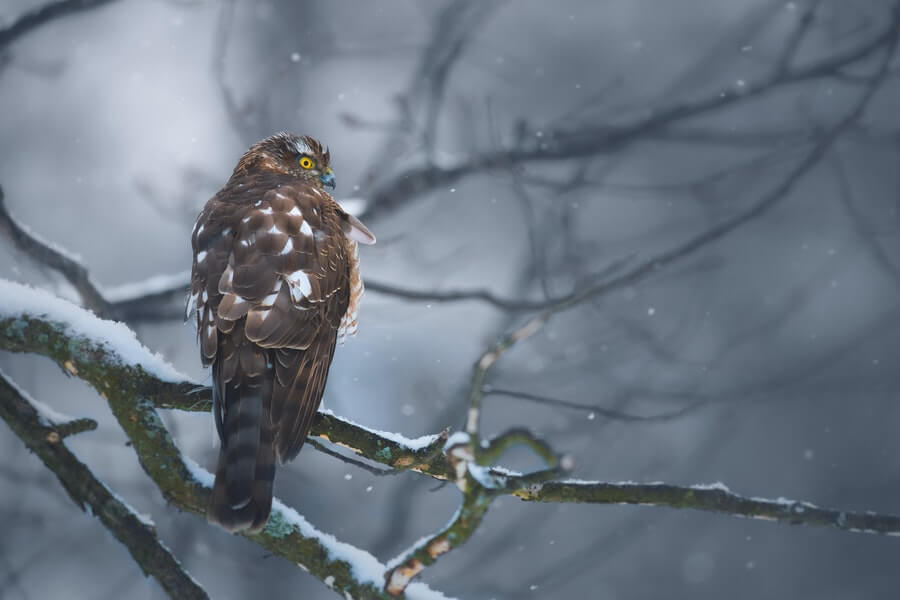
For all its small stature, the Sparrowhawk is quite an aggressive bird. It is also one of the most common birds of prey in the UK. Male and female sparrowhawks are quite different in appearance. For one, the females tend to be larger than males. Females and their young are usually brown with the males being the more noticeable with bluish brown backs and wings with orangey-brown stirpes on their chests.
Additional Information
- Conservation Status: Amber
- Where To Find Them: Sparrowhawks inhabit thick woodlands and gardens all over the UK except for the Scottish Highlands, The Western Isles and Shetland.
- What They Eat: Small birds
- Population: 35,000 breeding pairs
- Length: 28 to 38 cm
- Weight: Males 110 to 196 g / Females 185 to 342 g
- Wingspan: 50 to 70 cm
Goshawk (Accipiter gentilis)

The Goshawk is a fierce-looking bird in the hawk family. Its piercing eyes, sharp talons and beak make it a skilled hunter, but what really sets this bird of prey apart from other is its broad wings. These majestic birds can be black or brown with creamy, grey or white stripes. The Goshawk can fly at impressive speeds, even under the canopy of trees, earning the nickname the Phantom of the Forest. Its long legs and talons allow this bird to capture its prey in mid-flight and it can also swoop down to capture small mammals on the ground.
Additional Information:
- Conservation Status: Green
- Where To Find Them: Woodlands, farmland, grasslands and wetlands of Wales, Northern England and the forests of Scotland.
- What They Eat: Birds and small mammals
- Population: 280 to 430 breeding pairs
- Length: 48 to 62 cm
- Weight: Males 600 to 1000 g / Females 900 to 2000 g
- Wingspan: 135 to 165 cm
Peregrine Falcon (Falco peregrinus)
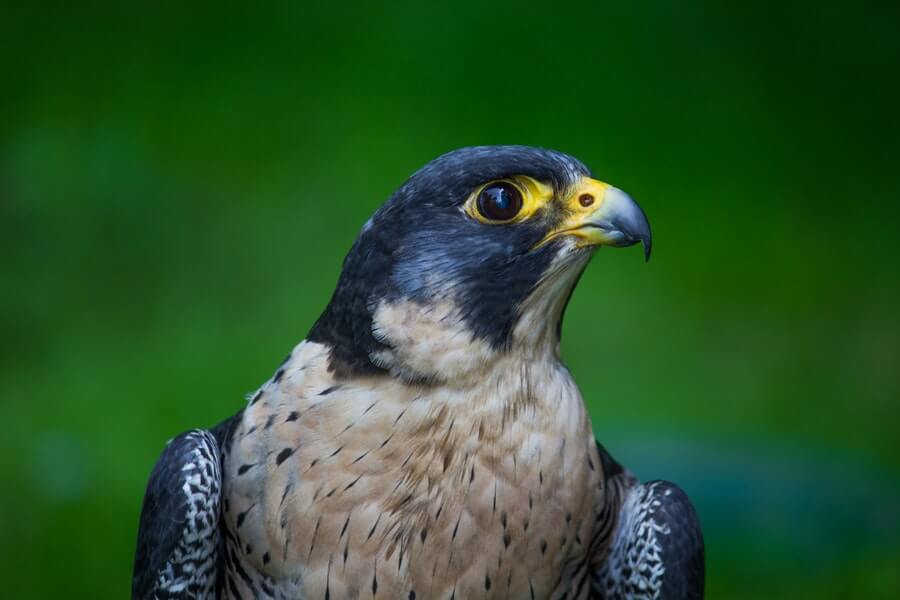
The peregrine falcon is a stunning bird with slate grey wings with a white, flecked underside and black bars across its chest. It has piercing black eyes and a pronounced hooked beak. Their numbers dropped to alarming levels but thanks to their being protected under The Wildlife And Countryside Act, they now enjoy a green conservation status with 1500 breeding pairs in the UK. These birds were often prized by the aristocracy and a famous for their speed while flying.
Additional Information
- Conservation Status: Green
- Where To Find Them: Northern and South Western England, Wales and Scotland, usually in marshlands.
- What They Eat: Peregrine falcons like to feast on small to medium sized birds but they also like to steal food from other birds.
- Population: 1500 breeding pairs
- Length: 39 to 50 cm
- Weight: 600 to 1300 g
- Wingspan: 95 to 115 cm
Osprey (Pandion haliaetus)

The Osprey is a rare bird of prey with brown feathers on their backs with a mottled white underside. Their beaks are hooked and very powerful. They also have long legs and talons which are designed to snatch fish from the water with ease. Osprey are migratory birds and migrate from Africa to the UK during warmer months.
Additional Information
- Conservation Status: Amber
- Where To Find Them: Osprey can be found in the wetlands, marine and intertidal areas of Scotland.
- What They Eat: Mainly fish. Osprey are quite adept at snatching fish from the water.
- Population: 200 to 250 breeding pairs
- Length: 52 to 60 cm
- Weight: 1200 to 2000 g
- Wingspan: 145 to 170 cm
Golden Eagle (Aquila chrysaetos)

The golden eagle is common in many places around the world and in the UK. These large birds of prey have predominantly brown feathers with black tips on their wings. Their underside is often cream-coloured or white and they have yellow legs and hooked beaks. The golden eagle is quite a common sight in many areas of the Northern Hemisphere. In the 19th century, these majestic birds were all but eradicated in the UK, but thanks to conservation efforts, they are back in the UK in healthy numbers.
Additional Information
- Conservation Status: Green
- Where To Find Them: The golden eagle is mainly found in the moorlands and highlands of Scotland.
- What They Eat: The golden eagle is a very skilled predatory bird and will eat small to medium mammals and other birds.
- Population: 440 breeding pairs
- Length: 75 to 88 cm
- Weight: Males 2.8 to 4.5 kg / Females 3.8 to 6.6 kg
- Wingspan: 204 to 220 cm
Sea Eagle (Haliaeetus albicilla)
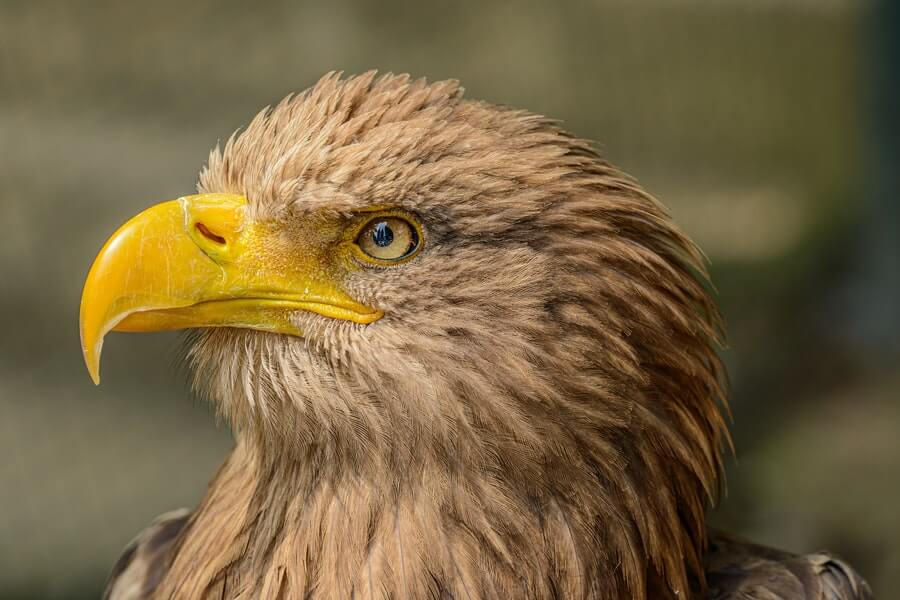
The sea eagle is the UK’s largest bird of prey and can often be seen flying over water hoping to snatch a fish. This beautiful bird has blackish-brown feathers with tan-coloured feathers on the head. They may also display some cream or white feathers on their wing tips. Their beaks are a bright yellow with a pronounced hoot that is very powerful.
Additional Information
- Conservation Status: Amber
- Where To Find Them: Sea eagles can be found mainly around areas of coastal Scotland, particularly around wetlands, farms and uplands. You can also see them in the British Isles as well as Ireland and England.
- What They Eat: The sea eagle is somewhat opportunistic and although they are avid hunters for fish, birds, rabbits and hares, they will also bully their way and take prey away from smaller creatures.
- Population: 150 breeding pairs
- Length: 70 to 90 cm
- Weight: Males 3.5 to 5 kg / Females 4 to 7kg
- Wingspan: 200 to 240 cm
Buzzard (Buteo buteo)
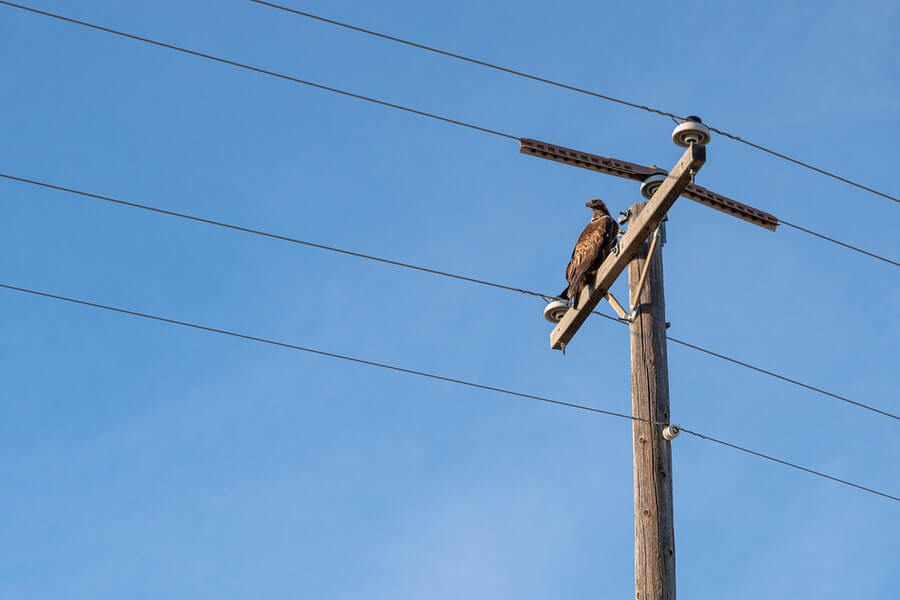
Buzzards are the UK’s most common birds of prey and can be found soaring through the air in almost every county within the country. Their name often has people confusing them with other birds of prey, such as vultures or condors, but the buzzards found in the UK are more related to eagles and hawks. Their feathers can be in different shades of black and brown with some white under the wings with yellow beaks that are hooked and powerful.
Additional Information
- Conservation Status: Green
- Where To Find Them: Buzzards are common all over the UK with largest populations in Scotland, Wales and The Lakes District. They can also be found in woodlands, grasslands and farmlands as well as towns and cities in almost every county in the UK.
- What They Eat: Buzzards have a voracious appetite and will eat small mammals, birds, carrion, as well as worms and large insects when other food sources are scarce.
- Population: 57,000 to 79,000 breeding pairs
- Length: 51 to 57 cm
- Weight: Males 550 to 1000 g / Females 700 to 1300 g
Honey Buzzard (Pernis apivorus)

The European Honey Buzzard, also known as the pern, is quite a beautiful bird, for all that it is a bird of prey. While the numbers in the UK are somewhat alarming, their numbers have been increasing in recent years due to extra protection with certain conservation laws. They can be found in various shades of brown or black with some honey buzzards displaying feathers in shades of grey, cream and white. These birds have short yellow beaks with a slight hook.
Additional Information
- Conservation Status: Amber
- Where To Find Them: Honey buzzards can be found in woodlands around Southern and Eastern England as well as Northern Scotland.
- What They Eat: Mainly larvae from wasps and bees
- Population: 41 breeding pairs
- Length: 52 to 60 cm
- Weight: 600 to 1100 g
- Wingspan: 135 to 150 cm
Hen Harrier (Circus cyaneus)
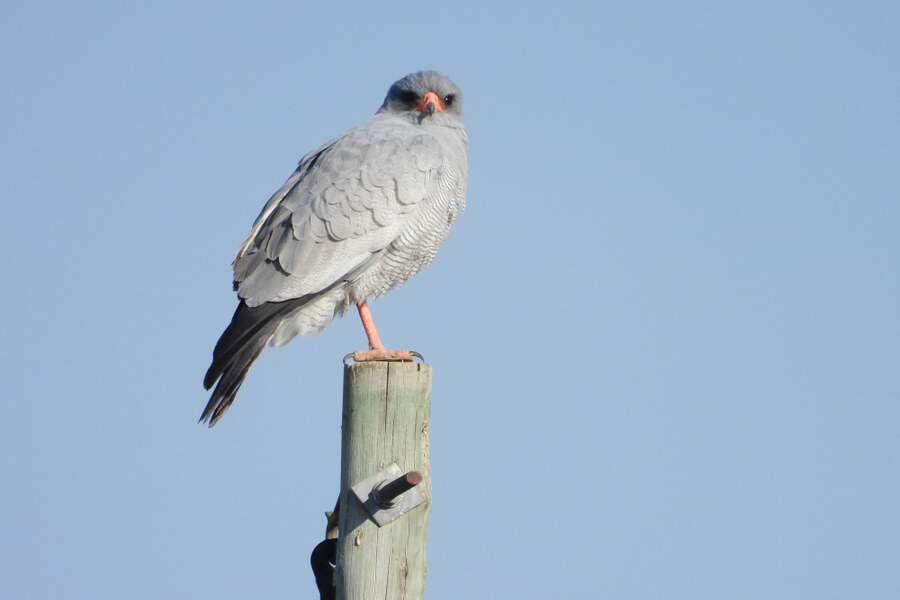
The hen harrier got its name from originally swooping down and preying on free-range chickens and other fowl. Their numbers have been seriously affected due to being hunted and shot by farmers and hunters as the hen harrier was a threat to grouse populations. They now enjoy extra protection so their numbers are on the rise again.
Additional Information
- Conservation Status: Red
- Where To Find Them: Hen harriers are often found around farmland and coastal areas as well as grassland and wetland. Their numbers are on the rise in Wales, Northern Ireland and Scotland.
- What They Eat: Hen harriers’ diet mainly consists of small birds and mammals.
- Population: 617 breeding pairs
- Length: 44 to 52 cm
- Weight: Males 300 to 400 g / Females 400 to 600 g
- Wingspan: 100 to 120 cm
Marsh Harrier (Circus aeruginosis)
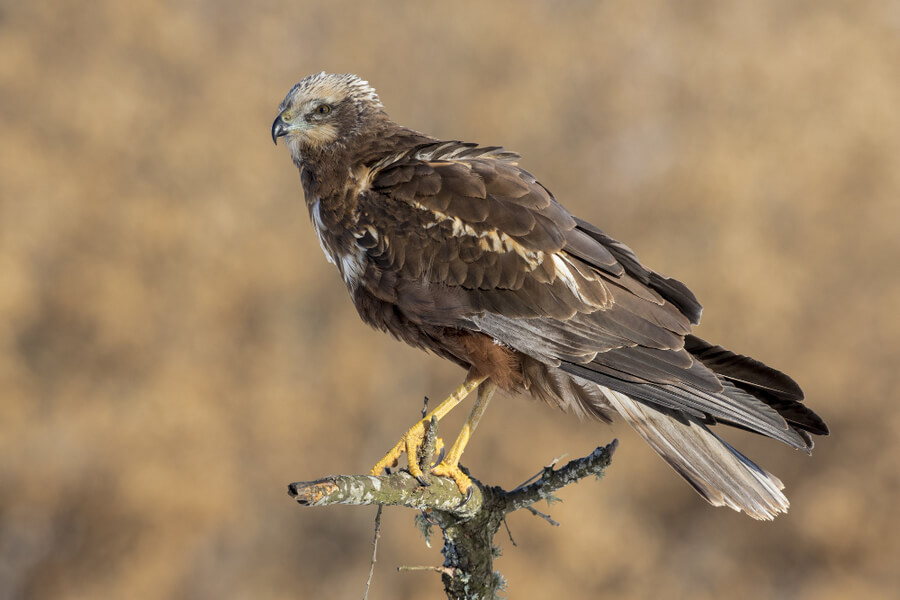
The marsh harrier is the largest of the harriers and the males have some vividly beautiful colouring. While the females and juveniles have brown, black and cream feathers, the males have a more eye-catching display with the addition of grey and white. Their bodies have a distinctive “V” shaped formation in brown or black with the rest of their wings flashing with pale grey or white.
Additional Information
- Conservation Status: Amber
- Where To Find Them: Look for the marsh harrier around coastal areas of Eastern or South-Eastern England. You can also find them in farmland and wetlands as well as some of the UK’s best nature reserves.
- What They Eat: Marsh harriers eat small birds and mammals.
- Population: 400 breeding pairs
- Length: 48 to 56 cm
- Weight: Males 400 to 660 g / Females 540 to 800 g
- Wingspan: 115 to 130 cm
Montagu’s Harrier (Circus pygargus)
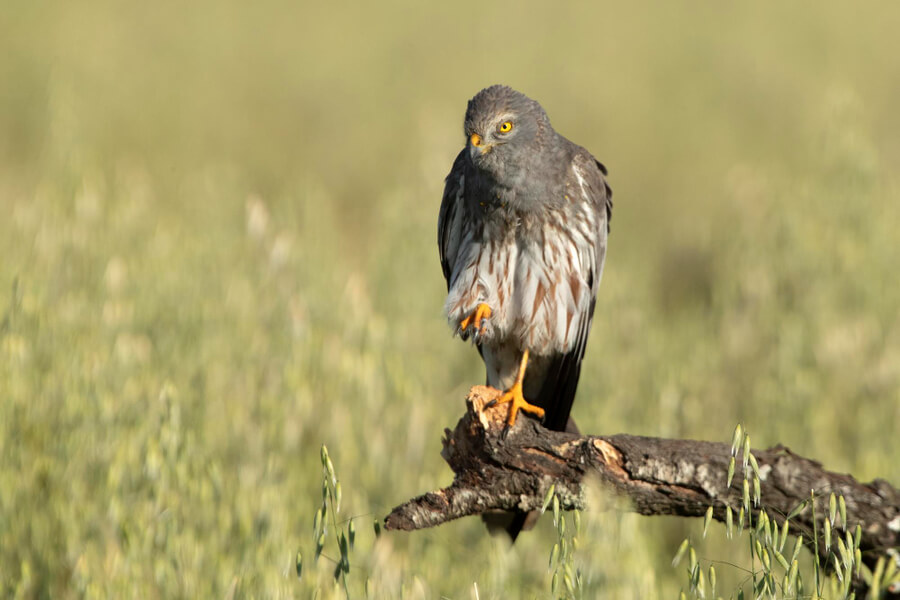
The Montagu’s Harrier is possibly the UK’s rarest bird of prey and their locations are generally kept secret to prevent their eggs being stolen by poachers. The numbers in the UK have dropped to alarming numbers and they are protected under various conservation protection laws. The females of this beautiful bird are dark brown while the males are mainly grey with black wingtips with a black stripe on the underside of their wings.
Additional Information
- Conservation Status: Red
- Where To Find Them: Montagu’s Harriers can be found in wetlands and farmlands across coastal areas of Southern and Eastern England. Their actual locations are not made public to protect them and their eggs.
- What They Eat: Montagu’s Harriers eat small birds, shrews, rabbits, small reptiles and insects.
- Population: 5 breeding pairs or less
- Length: 43 to 47 cm
- Weight: 225 to 450 g
- Wingspan: 100 to 120 cm
Kestrel (Falco tinnunculus)

If you’re on the lookout for a Kestrel, don’t look in the trees as kestrels don’t seem to like densely forested areas. They have, however, adapted quite well to urban areas and can even be found in some cities. These birds are a smaller size, and their feathers are brown or black. They may also have a brilliant splash of red and orange on their wings. Their wings are pointed and they have long tails.
Additional Information
- Conservation Status: Amber
- Where To Find Them: Kestrels can be found in rural areas, heathland and urban areas.
- What They Eat: Small mammals and birds as well as worms and insects
- Population: 46,000 breeding pairs
- Length: 32 to 35 cm
- Weight: 156 to 252 g
- Wingspan: 71 to 80 cm
Merlin (Falco columbarius)

While the merlin may not be a native UK bird of prey, it has taken up residence in the UK due to the climate. These birds, like many others, have made the move to the UK from areas further north such as Iceland. Merlins are the smallest birds of prey (UK) and have quite the rapid wingbeat. The males are mainly black or brown with blue wings and white around the neck.
Additional Information
- Conservation Status: Red
- Where To Find Them: Look for merlin in coastal areas, uplands and rural areas along the southwest of England. They prefer the open country and can be seen soaring over these areas in search of food.
- What They Eat: The merlin’s diet consists mainly of small birds
- Population: 900 to 1500 breeding pairs
- Length: 25 to 30 cm
- Weight: Males 125 to 234 g / Females 164 to 300 cm
- Wingspan: 50 to 62 cm
Hobby (Falco Subbuteo)

The hobby is a bird with great flying skills. This small, slim bird is capable of accelerating with intense speed and even includes a lot of impressive aerial moves. It will chase its prey and even scare off larger birds. These birds have long pointed wings and large talons that they use to swoop and grab their prey. They have black, blue or brown feathers and white or grey stripe formations on their bodies.
Additional Information
- Conservation Status: Green
- Where To Find Them: Hobby can be found in many areas in the south of England, in particular around farming areas, woodlands and even in the suburbs.
- What They Eat: Small birds and insects
- Population: 2800 breeding pairs
- Length: 28 to 36 cm
- Weight: 131 to 340 g
- Wingspan: 70 to 90 cm
Our Birds of Prey In The UK
No matter where in the UK you live, you are sure to encounter birds of prey. While you may consider them a nuisance, think of the important role they have in keeping the numbers of rodents, reptiles, insects and other animals to levels that are optimal for that area. Birds of prey UK are also essential at keeping their habitats clean of weak animals and their carcasses. You can help increase or maintain viable numbers of these wonderful birds but making sure nothing you do can cause them harm and even leave wild bird food out for some of them. Do your bit to prevent some of these majestic birds from disappearing from UK shores.
Sources
[i] https://www.rspb.org.uk/birds-and-wildlife/advice/wildlife-and-the-law/wildlife-and-countryside-act/#:~:text=The%20Wildlife%20and%20Countryside%20Act,is%20given%20in%20these%20pages.
[ii] https://www.rspb.org.uk/birds-and-wildlife/advice/wildlife-and-the-law/wildlife-and-countryside-act/exceptions/
Gemma Sharp is the resident writer for Love Garden Birds, a supplier of premium bird food and accessories. She has had a genuine love for our feathered friends from a young age, and has dedicated a lot of her time to learning all there is to know about them. If you’re struggling to pick the right bird feed for your garden, need help identifying a type of wild bird, or can’t decide where to put a nesting box, Gemma is the person to go to! She is passionate about sharing her years of learnt knowledge with the public. In her free time, she can be found feeding birds at home with her three young boys.



